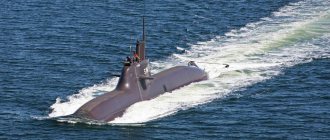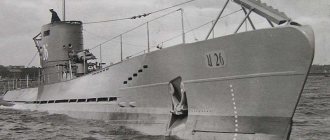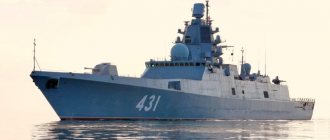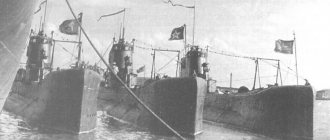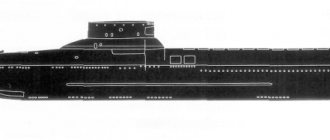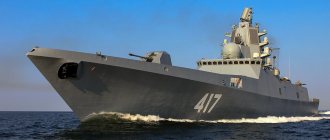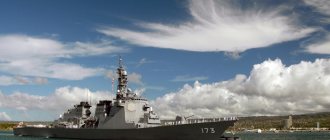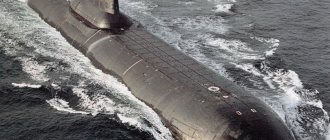| K-119 "Voronezh" | |
| Ship history | |
| Flag State | Russia |
| Home port | Zaozersk |
| Launching | 1989 |
| Current status | in reserve |
| Main characteristics | |
| Ship type | SSGN |
| Project designation | 949A "Antey" |
| Chief designer | I.L.Baranov |
| NATO incorporation | "Oscar II" |
| Speed (surface) | 15 knots |
| Speed (underwater) | 32 knots |
| Working depth | 520 m |
| Maximum immersion depth | 600 m |
| Sailing autonomy | 120 days |
| Crew | 107 people |
| Dimensions | |
| Surface displacement | 14,700 t |
| Displacement underwater | 23,900 t |
| Maximum length (according to KVL) | 154 m |
| Body width max. | 18.2 m |
| Average draft (according to waterline) | 9.2 m |
| Power point | |
| 2 OK-650V nuclear reactors with a capacity of 190 MW each | |
| Armament | |
| Mine and torpedo weapons | 2x650 mm and 4x533 mm TA 24 torpedoes |
| Missile weapons | 24 P-700 Granit missiles (3M45) |
| Air defense | MANPADS "Igla-1", "Verba" |
This term has other meanings, see Voronezh (meanings).
K-119 "Voronezh"
- Russian nuclear-powered missile-carrying submarine cruiser Project 949A "Antey", part of the 11th submarine division of the Northern Fleet of the Russian Navy. The boat inherited the guards flag from the SSGN K-116 of Project 675, which received the flag from the Shch-422, which did not have time to raise it[1].
History[ | ]
The laying of the ship took place in February 1986 at Sevmash under serial number 636. It was included in the lists of Navy ships on March 10, 1987 and classified as a nuclear submarine.
It was launched in December 1988, and the reactor was launched for the first time in April 1989[2].
From 1990 to 1991 it was under repair in Severodvinsk.
On June 3, 1992, she was reclassified as a nuclear submarine cruiser.
On April 6, 1993, it received the name “Voronezh” in connection with the establishment of patronage over it by the Voronezh administration.
In April 1995, together with the cruiser Orel of the same type, he carried out a joint voyage to solve the problem of mutual target detection using the sonar.
In 1996-1999 the cruiser undertook three autonomous campaigns for combat service (February - March 1996, February - April 1997, August - October 1997).
During its first combat service in the Mediterranean Sea, the cruiser supported the operations of a detachment of ships of the Russian Navy led by the TAVKR "Admiral of the Fleet of the Soviet Union Kuznetsov".
From June 22 to June 26, 1999, the cruiser took part in the Zapad-99 strategic command and staff exercises, during which it conducted practical missile firing.
In 2006, he arrived at the Zvezdochka enterprise for emergency repairs of the main turbine, as well as replacement of the cores of a nuclear reactor[3]. In December 2008, it was placed in a docking chamber[2]. In March 2009, repairs and modernization began[4]. On May 26, after completing a technical readiness restoration course with elements of medium repairs, the vessel was launched and transferred to the outfitting quay[5][2][6].
In November 2011, based on the results of the work carried out, the cruiser’s service life was extended by 3.5 years[3]. The ship returned to its permanent deployment point in March 2012[7].
On June 8, 2014, the cruiser Voronezh rescued the crew of the small boat Barents-1100 in the White Sea, which ran out of fuel while trying to bypass an area with unfavorable weather conditions[8].
In September 2014, while participating in tactical exercises of heterogeneous forces of the Northern Fleet, the cruiser carried out single firing from an underwater position at a surface sea target with a Granit cruise missile[9].
In October 2022, he successfully fired a Granit anti-ship cruise missile at a conditional target in the area of the Novaya Zemlya archipelago[10].
It was put into reserve before being decommissioned, and in July 2022 the name “Voronezh” was given to the new nuclear submarine of Project 885M “Yasen-M” for the Northern Fleet.[11]
Description of design
Submarines of the Antey project are made according to a double-hull design: an internal durable hull is surrounded by a lightweight external hydrodynamic hull. The aft part of the vessel with its tail and propeller shafts generally resembles the Project 661 nuclear submarine.
The double-hull architecture has a number of advantages: it provides the ship with an excellent reserve of buoyancy and increases its protection against underwater explosions, but at the same time significantly increases the ship's displacement. The underwater displacement of the nuclear submarine of this project is approximately 24 thousand tons, of which about 10 thousand are water.
The durable hull of the submarine has a cylindrical shape, the thickness of its walls is from 48 to 65 mm.
The body is divided into ten compartments:
- torpedo;
- management;
- combat posts and radio room;
- Living spaces;
- electrical equipment and auxiliary mechanisms;
- auxiliary mechanisms;
- reactor;
- GTZA;
- rowing electric motors.
The ship has two areas for crew rescue: in the bow, where the pop-up camera is located, and in the stern.
The submarine's crew number is 130 people (according to other information - 112), the vessel's navigation autonomy is 120 days.
The Antey submarine cruiser has two OK-650B water-water reactors and two steam turbines that rotate propellers through gearboxes. The ship is also equipped with two turbogenerators, two DG-190 diesel generators (800 kW each) and two thrusters.
Submarines of the Antey project are equipped with the MGK-540 Skat-3 sonar system, as well as space reconnaissance, target designation and combat control systems. The cruiser can receive information from a satellite system or from aircraft in an underwater position using special antennas. The boat also has a towed antenna, which extends from a pipe located on the stern stabilizer.
The 949A submarines are equipped with the Symphony-U navigation system, which is characterized by increased accuracy, a large range and can process a significant amount of information.
The main type of nuclear submarine weapons are P-700 Granit anti-ship missiles. Missile containers are located on both sides of the wheelhouse, outside the boat's durable hull. Each of them has an inclination of 40°. The missile can carry a conventional (750 kg) or nuclear warhead (500 Kt). The firing range is 550 km, the missile speed is 2.5 m/s.
The submarine cruiser can conduct both single firing and launch anti-ship missiles in one salvo, firing up to 24 missiles at a time. Granit anti-ship missiles have a complex trajectory, as well as good noise immunity, which makes them a serious threat to any enemy. If we talk about the defeat of an aircraft carrier order, then the likelihood of this is especially high during salvo fire. It is believed that to sink an aircraft carrier, nine Granites must hit it, but even one accurate shot is enough to prevent aircraft from taking off from its deck.
In addition to missiles, Project 949A Antey submarines also have torpedo weapons at their disposal. The submarines have four torpedo tubes with a caliber of 533 mm and two with a caliber of 650 mm. In addition to regular torpedoes, they can fire missile torpedoes. Torpedo tubes are located in the bow of the ship. They are equipped with an automatic loading system, so they have a high rate of fire - the entire ammunition can be fired in just a few minutes.
Commanders[ | ]
- 1988-1996: guard cap. 1st Rank V. A. Kizilov
- 1996-1999: guard cap. 1st rank Efimov N.A.
- 1999-2002: guard cap. 1st Rank Sidorov I. N.
- 2002-2005: guard cap. 1st Rank Pokrasov A.V.
- 2005-2006: guard cap. 1st rank Lyapin Ruslan Fuadovich[12].
- 2006-2007: guard cap. 1st Rank Shulga P.N.
- 2007—2016: guard cap. 1st rank Zhurov V. A.[1][2]
- 2016-2017: guard cap. 2nd rank Kuznetsov A.A.
- 2017-present time of guard cap. 1st Rank Abramov A.L.
Commanders of the 2nd crew[ | ]
(150th crew)
- 1991-1997 - cap. 1st rank Ezhov S. N.
- 1997-1998 - cap. 1st Rank Abramov K.K.
- 1998-2001 - cap. 1st rank Yakubina O. G.[13]
Characteristics
Below are the characteristics of the Project 949A nuclear submarine:
- displacement above, m.cub. – 12500;
- underwater displacement, cubic meters – 22500;
- power plant – 2 × OK-650 (with a power of 2 x 190 MW);
- surface speed, knots – 15;
- underwater speed, knots – 32;
- Max. immersion depth, m – 600;
- autonomy, days – 120;
- crew, people – 94;
- armament - 24 anti-ship missiles "Granit", TA 650 mm - 4 pcs., TA 533 mm - 4 pcs.
Notes[ | ]
- ↑ 12
Guardsman in the third generation // “Northern Worker” (December 11, 2008) - ↑ 1 2 3 4 Popov, Anatoly
“Voronezh” in its native element
(unspecified)
. Asterisk (June 4, 2009). Access date: February 20, 2010. Archived March 2, 2012. - ↑ 1 2
The Voronezh nuclear submarine has undergone modernization
(unspecified)
. lenta.ru (November 23, 2011). Access date: November 23, 2011. - “Zvezdochka” to Russia’s nuclear shield // “Red Star” (March 5, 2009)
- The Voronezh nuclear submarine was launched at Zvezdochka // regnum.ru (May 26, 2009)
- (unspecified)
was launched in Severodvinsk . Lenta.ru (May 26, 2009). Access date: September 21, 2010. - The nuclear submarine "Yuri Dolgoruky" will join the Northern Fleet this year (unspecified)
. ITAR-TASS (March 19, 2012). Retrieved March 19, 2012. Archived June 5, 2012. - In the White Sea, a missile carrier saved the boat crew // Lenta.ru (June 9, 2014)
- The Northern Fleet successfully launched cruise missiles in the Barents Sea // TASS (September 14, 2014)
- The submarine cruiser of the Northern Fleet "Voronezh" destroyed a conditional group of ships off the coast of Novaya Zemlya
- Submarine cruiser K-119, Voronezh. Project 949A (undefined)
.
deepstorm.ru
. Access date: July 13, 2022. - Voronezh colors in the Arctic // “Red Star” (July 12, 2005)
- Kostomuksha - “Voronezh” // “Karelia”: republican socio-political newspaper. - Petrozavodsk, 2001. - Issue. February 8, No. 15 (715). — P. 32. Archived May 9, 2005.
Nuclear submarine of project "Antey"
Below is a list of all nuclear submarines of this project:
- "Krasnodar". Disposed of at .
- "Krasnoyarsk". It is in the process of being dismantled; its name has already been assigned to another Project 885 submarine.
- "Irkutsk". Currently undergoing repairs and modernization under Project 949AM. Part of the Pacific Fleet.
- "Voronezh". It is in service with the Northern Fleet.
- "Smolensk". It is part of the Northern Fleet.
- "Chelyabinsk". It is part of the Pacific Fleet. Currently undergoing repairs and modernization under Project 949AM.
- "Tver". It is in service with the Pacific Fleet.
- "Eagle". It is undergoing renovations, which should be completed this year.
- "Omsk". It is part of the Pacific Fleet.
- "Kursk". She died in the Barents Sea on August 12, 2000.
- "Tomsk". Part of the Pacific Fleet, currently undergoing repairs.
Literature[ | ]
- Pavlov A. S. “Strike force of the fleet”, Yakutsk, 2001
- Aleksandrov Yu. I., Gusev A. N. “Warships at the turn of the XX-XXI centuries” part 1, “Galeya Print”, St. Petersburg, 2000
- Berezhnoy S. S. “Nuclear submarines of the USSR and Russian Navy”, MIA No. 7, Naval collection, 2001
- Apalkov Yu. V. “Submarines” vol.1 part 1, “Galeya Print”, St. Petersburg, 2002
- Apalkov Yu. V. Submarines of the Soviet fleet 1945-1991. Volume III. "MORKNIGA", 2012. ISBN 978-5-903081-43-1
| Submarines of Project 949 “Granit”/949A/AM “Antey” / Project 09852 | |
| |
Project evaluation
To assess the effectiveness of the Antey submarines, you should first of all pay attention to the main weapon of these submarine cruisers - the P-700 Granit anti-ship missiles.
Developed back in the 80s of the last century, today this complex is clearly outdated. Neither the range of this missile nor its noise immunity meet modern requirements. And the elementary base on which this complex was created has long been outdated.
In 2011, it was announced that specialists from the Rubin Central Design Bureau had developed a project to modernize the submarines of this project. First of all, it concerns the cruiser’s missile armament. Containers for the Granit anti-ship missiles will be replaced with launchers from which modern Onyx and Caliber missiles can be fired. This will turn Antea into a universal tool capable of solving a variety of problems.
Ships and submarines in service with the Main Directorate of Deep-Sea Research
Special purpose nuclear submarine BS-64 "Podmoskovye"
This article will discuss one of the most secret divisions of the Russian Ministry of Defense - the Main Directorate of Deep-Sea Research (GUGI). GUGI is directly subordinate to the Ministry of Defense and is engaged in deep-sea and oceanographic research, search and rescue of sunken ships, physiological studies of the influence of great depths on the human body, and testing of rescue equipment.
Service in the GUGI on special nuclear submarines and nuclear deep-sea stations (AGS) is considered the most dangerous and responsible. Immersion depths of 3-6 kilometers, secret tasks of national importance, the need for high technical literacy, knowledge of the operation of components and assemblies, and psychological stability required the formation of crews exclusively from officers and a medical examination during selection, similar to that for astronauts.
Hydronauts of the GUGI are the elite of the Russian submarine forces. The work of the 10th detachment of hydronauts of the GUGI was awarded the Order of Nakhimov. Apart from them, only the crews of the cruisers “Peter the Great”, “Varyag” and “Moscow” were awarded this order. It is the hydronauts and their work that are the most secret part of the GUGI.
The Main Directorate of Deep-Sea Research is armed with surface ships, nuclear submarines and deep-sea vehicles. Let's look at them in order.
Surface ships
Oceanographic research vessel of project 22010 “Kruys”
Oceanographic research vessels of project 22010 “Kruys”
are a series of special-purpose vessels for conducting comprehensive research of the World Ocean. The project's vessels can explore both the thickness of the ocean and its bottom. For these purposes, deep-sea manned and autonomous unmanned underwater vehicles are based on the vessel. Oceanographic vessels can also be used for rescue purposes - the equipment allows them to search for sunken objects on the seabed. The vessels have an equipped platform for one helicopter. The project vessel can operate in ice and, along with mapping, performs the functions of a universal surface and underwater reconnaissance aircraft.
The main special equipment of Project 22010 vessels are manned autonomous deep-sea vehicles of two types: Project 16810 “Rus” and Project 16811 “Consul”.
The project vessels have a displacement of 5,230 tons, a speed of up to 15 knots, a range of up to 8,000 miles, autonomy of 60 days and a crew of up to 60 people.
The propulsion system is equipped with two rudder propellers (RPP) driven by electric motors. Each RPK is capable of rotating 360 degrees, which ensures the retention of the OIS - even in a strong storm, the vessel can be positioned with virtually no displacement from a given point.
The reconnaissance capabilities of the vessels of the project are not known for certain, but the work of the Yantar vessel in October 2016 off the coast of Syria caused a wide resonance. The ship had been floating above undersea fiber optic cables for some time, and rumors about Yantar's ability to listen to such cables and even cut them were widespread in Western media.
Currently, the fleet includes one vessel of the project - "Yantar", the second vessel - "Almaz" is undergoing tests and will be transferred to the Navy this year.
Experimental vessel of Project 11982 “Ladoga”
Experimental research vessels of Project 11982
are designed to test special technical equipment, participate in search and rescue operations, and conduct scientific research and oceanographic work. These vessels are capable of operating in ice, mapping water areas, performing the functions of a universal deep-sea and surface reconnaissance vessel, and can perform the functions of a rescue and cable vessel.
The vessels have a maximum speed of 12 knots, a cruising range of 1000 miles, autonomy - 20 days, crew - 16 people, expedition composition - 20 people.
Currently, two vessels of Project 11982, “Seliger” and “Ladoga,” are in service in the Russian Navy. Another ship, the Ilmen, is under construction.
Floating transport dock for deep-sea research vehicles of project 22570 "Apartment"
The closed transport floating dock "Sviyaga" of project 22570 "Apartment"
has a lifting capacity of 3300 tons, length - 134 m, width - 14 m, draft 2.67 m. The transport dock is equipped with an automated control system work with payload (diving / ascent). The dock is used as a carrier for autonomous deep-sea vehicles. It also provides transportation of ships and vessels along inland waterways from north to south.
Multipurpose sea rescue tugboat project 20180 "Zvezdochka"
Project 20180 "Zvezdochka" rescue sea tugboats
are designed for search and rescue operations, testing of naval weapons and equipment. Vessels can also search and examine sunken objects. For these purposes, the vessel is equipped with a deep-sea vehicle of the Consul type or Project 18271 Bester SGA. To monitor underwater objects, the ship is equipped with remote-controlled uninhabited underwater vehicles “Tiger” and “Quantum”.
The vessels have a displacement of 5,500 tons, a maximum speed of 14 knots, and a crew of up to 70 people. The ships are equipped with a helipad for one Ka-27 helicopter, the ships are also equipped with equipment for towing other ships and three cargo cranes. Two stern cranes, with a lifting capacity of 80 tons and a lifting height of booms from 4.5 to 19 meters, carry out lowering and lifting of rescue vehicles or loading and unloading operations, and ensure the lifting of sunken, floating or bottom objects, including large ones.
The ships of this project are equipped with two diesel-electric power plants "Shorch" KL6538В-AS06 with 3625 hp each. each, as well as four diesel generators of 1680 kW and two generators of 1080 kW. The propulsors of the vessel are two fixed-pitch propellers on rudder propellers and two bow thrusters.
Today, the Navy has one vessel of the project - the lead ship Zvezdochka.
Oceanographic research vessel of project 20183 “Akademik Alexandrov”
The oceanographic research vessel of project 20183 “Akademik Alexandrov”
has a displacement of 5400 tons, a maximum speed of 14 knots, a crew of 65 people. The propulsion system is similar to that on Project 20180 vessels. The vessel has a takeoff and landing pad for one Ka-27 multi-purpose helicopter. The ice class of the Arc-5 vessel allows independent navigation in first-year Arctic ice with a thickness of up to 0.8 m in winter-spring navigation and up to 1 m in summer-autumn navigation. The navigation area is not limited.
"Akademik Alexandrov" is classified as an oceanographic research vessel and is described as "a multi-purpose vessel of reinforced ice class, designed to conduct research and scientific work on the shelf of the Arctic seas, support the operation of Arctic marine equipment, and rescue operations in the Arctic."
Currently, the fleet includes one vessel of the project - “Akademik Alexandrov”. The possibility of laying a second vessel is being considered.
Submarines, nuclear deep-sea stations, deep-sea manned vehicles
Special purpose nuclear submarine BS-136 "Orenburg"
Special purpose research nuclear submarine - carrier of manned deep-sea vehicles of project 09786 BS-136 "Orenburg".
Initially, the nuclear submarine was built according to project 667BDR "Kalmar" and entered the fleet in 1981, but in 1996 it was assigned to the subclass of special-purpose nuclear submarines. After appropriate modernization, the Orenburg entered the fleet in 2006 as a special-purpose nuclear submarine. The submarine has an underwater displacement of 15,000 tons. The power plant consists of two pressurized water reactors VM-4S.
On September 27, 2012, during the Sevmorgeo expedition, the BS-136 Orenburg, acting as the carrier of a deep-sea nuclear research station - the AS-12 submarine of project 10831, known as Losharik, reached the North Pole.
The current status of the submarine is unknown. Perhaps it is under repair at the Zvezdochka Center.
Special purpose nuclear submarine of project 09787 BS-64 “Podmoskovye”.
Built according to project 667BDRM "Dolphin" and entered the fleet in 1986. In 1999, the nuclear submarine was sent to the Zvezdochka Center for repairs and re-equipment under Project 09787. On December 26, 2016, after the modernization of the special-purpose nuclear submarine BS-64 Podmoskovye, it was transferred to the fleet. The nuclear submarine has the following characteristics: underwater displacement of 18,200 tons, maximum diving depth of 550-650 m, crew - 135-140 people. Power plant – 2 VM-4SG reactors with a total capacity of 180 MW.
Nuclear deep-water station of project 18510 "Nelma"
Nuclear deep-water station of project 18510 "Nelma".
Presumably, the complex was created to conduct reconnaissance operations, interfere with combat patrol routes of nuclear-powered ships of the Russian Navy, solve scientific and technical problems, rescue people in extreme situations, operations to lift various equipment from military equipment of a potential enemy sunk at sea, and for other special operations .
AGS of the Nelma project have a total displacement of about 1000 tons and are equipped with one reactor with a capacity of 10 MW. The case is made of titanium alloy. During the design, a deckhouse was not provided for, but due to the fact that the hatch of the airlock compartment was filled with water even with slight sea waves, it was later installed during the next repair. AGS are not armed. To carry out deep-sea diving work, they are equipped with a pressure chamber. Capable of diving to depths of up to 1000 m.
According to projects 18510 and 18510.1, 3 AGS were built, according to open sources, all of them are part of the fleet. Their carriers are BS-136 and possibly BS-64.
Nuclear deep-water station of Project 1910 "Sperm Whale"
Nuclear deep-sea station of Project 1910 "Sperm Whale"
have an underwater displacement of 2000 tons, an underwater speed of 30 knots, a diving depth of more than 1000 m, a crew of 36 GUGI officers. The submarine's hull is made of titanium alloys. Probably, the submarine has an improved propulsion system, which has several lateral systems that change the vector of movement of the submarine. With the help of these small maneuvering engines, the Sperm Whale can “hover” above the basalt ocean floor.
The following equipment is supposedly installed on board the submarine: an echo sounder, a television observation system, a side-scan sonar, a magnetometer, a satellite navigation system, a high-frequency profiler, photographic equipment for shooting deep-sea objects, a remote-controlled robotic manipulator, a water sampling system, a pressure chamber for divers and an exit system divers on the ground.
According to open sources, the fleet includes 3 AGS of the Sperm Whale project, but their exact status is unknown.
Nuclear deep-water station of project 10831 “Kalitka”
Nuclear deep-water station AS-12 of project 10831 “Kalitka”
or “Losharik” - the name by which it is known to the general public, was accepted into the fleet around 2010. AGS has a total displacement of 2000 tons. The hull of the deep-sea station is assembled from high-strength titanium compartments, spherical in shape, in which the principle of a bathyscaphe is implemented. All compartments of the boat are interconnected by passages and are located inside a lightweight hull. According to various sources, the AGS can dive to depths from 3000 to 6000 m.
The station does not have any weapons, but it is equipped with a manipulator, a telegraft (a bucket with a television camera), a dredge (a rock cleaning system), and a hydrostatic tube. The Losharik crew consists of 25 people - all officers. Losharik can remain submerged for several months.
The presumptive carrier of the project's AGS is the special-purpose nuclear submarine BS-136 Orenburg.
Research autonomous deep-sea station of project 16811 “Consul”
Research autonomous deep-sea stations of projects 16810 “Rus” and 16811 “Consul”
are based on ships of projects 22010 “Kruys” and 20180 “Zvezdochka”. Bathyscaphes are built according to similar designs and have slight differences. The AS-37 of the Rus project entered the fleet in 2007, the AS-39 in 2011. “Rus” has a total displacement of 25 tons and can dive to a depth of 6000 m, “Consul” has a displacement of 26 tons and is capable of diving up to 6270 m. The crew of the bathyscaphes is 2-3 people. The devices have a lifespan of 500 dives to a depth of more than 4000 m and 1000 dives to a depth of up to 4000 m.
Purpose of devices pr.16810 and 16811: 1) classification and video recording of objects on the seabed; 2) performing underwater technical work using a manipulator device; 3) inspection of underwater structures and objects; 4) delivery to the ground or lifting to the surface of objects weighing up to 200 kg.
DeepWorker 2000 underwater vehicle The
DeepWorker 2000 underwater vehicle
is based on the Seliger experimental vessel of Project 11982. The Canadian-made device is capable of diving to depths of up to 1000 m, the duration of the dive is 6 hours in normal mode and 80 hours in emergency mode. DeepWorker 2000 is equipped with 4 thrusters, each with a power of 1 hp. every. It is possible to install a wide range of additional equipment on the device: manipulators, video cameras, sonar, Doppler log, hydroacoustic navigation system. The device has a hemispherical dome, providing excellent visibility to the pilot. The dimensions of the dome make it easy to take photos or videos with non-specialized cameras without the need to use expensive underwater cameras or boxes. The relatively small weight - 1800 kg - and the compactness of the device allow the device to be lowered and lifted by any ship-based non-specialized crane of sufficient lifting capacity, as well as transported by any type of transport. The Deep Worker is controlled by a single pilot.
Projects under construction
In the interests of GUGI, quite intensive construction of ships and nuclear submarines is currently underway. Next we will talk about the projects that should soon enter service with the GUGI.
Oceanographic research vessel of project 02670
The oceanographic research vessel "Evgeniy Gorigledzhan" of project 02670
is created on the basis of the rescue tug MB-305, built in Poland, at the Szczecin shipyard in 1983 and served in the Northern and Baltic fleets, which reduced the cost of its construction by 40%. According to project 02670, it will be converted to carry out underwater technical work, environmental monitoring of the marine environment, oceanographic survey of the bottom layer, and assist search and rescue forces at sea. The ship will take on board manned deep-sea vehicles of the Rus and Consul types and rescue vehicles of the Bester type. The vessel's displacement is 4000 tons, autonomy is 30 days, crew is 32 people and 25 expedition members. The vessel is scheduled to enter service in 2022.
Oceanographic research vessel of project 16450 "Garage-Guys"
Oceanographic research vessel "Akademik Ageev" of project 16450 "Garage-Guys".
There is little information about the ship. “Akademik Ageev” is so secret that even its geometric dimensions and displacement have not been revealed. Since the vessel is oceanographic, that is, intended for navigation in the ocean zone, making the longest voyages, including to the shores of the United States, it belongs to the first rank. In this connection, we can assume that its displacement is no less than 10,000 tons, and perhaps more. It is known that it provides a set of forces and means for research, including with the help of deep-sea unmanned vehicles, the possibility of which is provided on this ship.
Special purpose nuclear submarine K-329 "Belgorod" of project 09852
The special purpose nuclear submarine K-329 "Belgorod" of project 09852
was initially built according to project 949A "Antey", but in 2012 the submarine was re-laid to a new project. During completion and refurbishment, the length of the nuclear submarine increased from 154 to 184 m, the width of the hull was 18.2 m, which makes Belgorod the largest submarine in the world.
The underwater displacement of the nuclear submarine is, according to open data, 30,000 tons, the maximum diving depth is 600 m, the underwater speed is 32 knots, the crew is 107 people. The power plant consists of two OK-650V reactors with a power of 190 MW each.
The main armament of the Belgorod should be Poseidon nuclear torpedoes (the media report that the nuclear submarine is capable of carrying 6 such torpedoes), and the submarine can also carry Project 10831 Kalitka AGS and deep-sea unmanned vehicles of the Harpsichord-2R-RM type.
The submarine is expected to enter service this year.
Infographics dedicated to the special-purpose nuclear submarine "Khabarovsk" of project 09851
If little is known about the nuclear submarine Belgorod, then almost nothing is known about
the special-purpose submarine Khabarovsk of Project 09851
. There is not even exact information whether it will be subordinate to the GUGI. It is assumed that the nuclear submarine will be equipped with a new type of reactor and, like the Belgorod, it will carry Poseidon strategic nuclear torpedoes.
Estimated characteristics of "Khabarovsk": length - up to 120 m, displacement - up to 10,000 tons, maximum diving depth - 400-500 m, propulsion system - 1 nuclear reactor and water-jet propulsion. It is assumed that the submarine uses many design solutions previously tested on the Project 955 Borei nuclear submarine.
According to plans, Khabarovsk should enter service in 2022.
Conclusion
The secrecy of the activities of the GUGI makes it difficult to objectively assess the work of the department.
However, the fact that the most modern oceanographic vessels, nuclear submarines and deep-sea vehicles are being built for the department indicates that the state highly values the work of the Main Directorate of Deep-Sea Research and is ready to invest in it. Undoubtedly, GUGI is working for the future, because it has long been known about the enormous natural resources concentrated at great depths under water. For example, huge reserves of oil and gas have been discovered on the Russian Arctic shelf.
However, the leading role is given to military missions. Here is the opportunity to influence the deep-sea communications of a potential enemy, and the creation of new types of weapons capable of operating at great depths, and missions to lift particularly important objects from the ocean floor.
Therefore, the work of GUGI in the coming years will receive decent funding and logistical support.
However, if the future of GUGI looks cloudless, then all is not so well for other departments of the fleet. But more on that in the next article.
To be continued…
